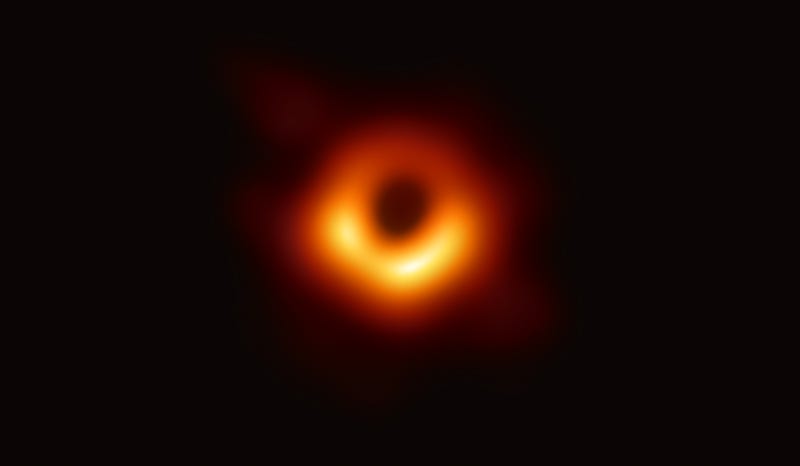Hello Earthlings.
QUICK! I need to mention - have you heard about tonight’s blood moon? You should definitely look up to find the moon blushing tonight in the Earth’s shadow. If it’s cloudy where you are or if you’re not in the viewing region, you can tune into plenty of livestreams! This is the longest lasting total lunar eclipse for decades to come (clocking in at around 85 minutes!), it is not to be missed!

let’s go
volume (8):
Now that’s what I call Science(!)

Fellow Earthlings. Woooooooooowwwwwww. Not only is this the just second direct image ever to be produced of a black hole, this is an extra special image because it features THE SUPERMASSIVE BLACK HOLE at the center of our HOME GALAXY - THE MILKY WAY!
How in the what?(!) Let’s get into it.
First I would like to mention that both direct images of black holes in existence are in radio wavelengths. I know the first question you had was: hold on. Black Holes... Aren’t they supposed to be big scary things that eat up everything that gets too close to them? Shouldn’t I, in fact, not be able to see one? And, you’d be correct. You shouldn’t be able to see one with your own eyes, but if you had fancy radio glasses you might see something that looks remarkably similar to these images.
We have talked about black holes a bit before, but never have we had so much information to discuss specifically about our home galaxy’s central black hole (!).
In order to produce this image, the team enlisted the help of 8 different radio telescopes across the globe. Working together in pairs, the radio telescopes peered through the galactic plane full of gas and dust and star matter to observe the supermassive black hole dubbed Sgr A* at the heart of our galaxy; producing about 3.5 petabytes of observational data all together. This data was then analyzed and combined with more bytes of visualizations made by supercomputers based on the observations and the laws of physics as we understand them. The two datasets together when analyzed and compared make not only the image possible but also many other scientific wonders worth noting.
For example, all of the simulations based on the observations (and the observations themselves) produced the same diameter for the shadow of Sgr A* (the shadow of a black hole is essentially the appearance of its Event Horizon - the heart of a black hole). This diameter result is in agreement with the predictions based on previous decades worth of observations of the motions of stars near the galactic center - which had given scientists an estimate of the mass of the object (Sgr A*) those stars orbit at the heart of our galaxy. Knowing the mass of the object, they are able to use Einstein’s theory of relativity to predict the size of the shadow the black hole should produce if imaged. And they do agree. This is a great triumph for Einstein’s explanation of gravity.
But wait a second. The shadow of a black hole… its Event Horizon… wouldn’t that all be nice and swell if we were looking at the black hole face on? But isn’t this the SMBH at the center of our galaxy? And didn’t I just talk about how the telescopes had to peer through light years of gas and dust through the galactic plane just to catch this glimpse? So, am I crazy to think I’d be looking at the central black hole EDGE ON? Not FACE ON?
It’s true. The team also discovered that Sgr A* is not aligned with the galactic plane as suspected. It is in fact FACING OUR WAY. Slightly askew on the plane of our galaxy. One of the teams within the giant endeavor that is the EHT collab was responsible for producing 5 million+ simulations of possible black holes from every possible viewing angle. Based on these simulations and what was actually observed, it is clear that the Sgr A* appears to be facing us.
Do you remember in 2019 when the Event Horizon Telescope team published the first ever image of a black hole?

A few key differences between these two seemingly similar behemoths in space: M87* lives roughly 55 million light years away, whereas Sgr A* lives a mere 26,000 light years away. M87* is 1,500 times larger than Sgr A*(!). M87* appears to be consuming more material more quickly and more efficiently than Sgr A*. M87* is considered one of the largest and most extraordinary black holes we know of in the Universe. Sgr A* although not as exquisite, is considered to be more exciting by those who care, because of its mediocrity. Sgr A* provides Earthling scientists with a laboratory to observe a more common celestial phenomenon. Despite being known for their generous appetites, surely these two have more secret cosmic snacks we’ve yet to discover.
Primary Sources (all open access) for more black hole deep diving:
I. The Shadow of the Supermassive Black Hole in the Center of the Milky Way
II. EHT and Multiwavelength Observations, Data Processing, and Calibration
III. Imaging of the Galactic Center Supermassive Black Hole
IV. Variability, Morphology, and Black Hole Mass
V. Testing Astrophysical Models of the Galactic Center Black Hole
VI. Testing the Black Hole Metric
The Entire Focus Piece from The Astrophysical Journal Letters
“No great discovery was ever made without a bold guess.” - Sir Isaac Newton






